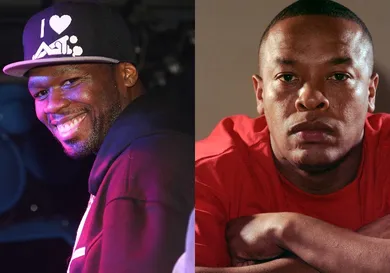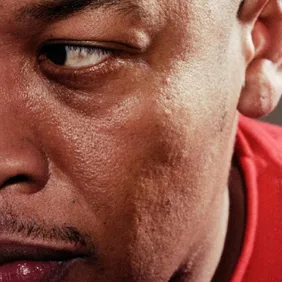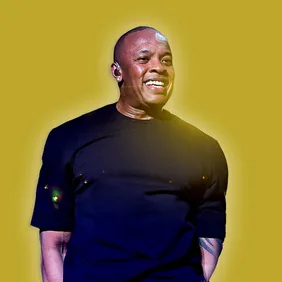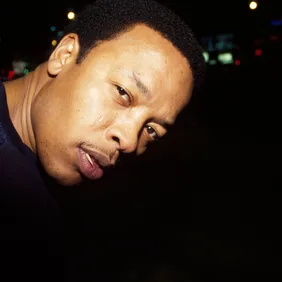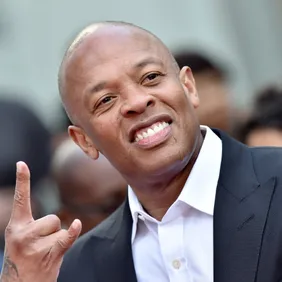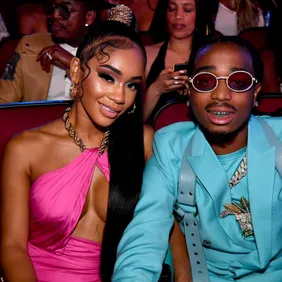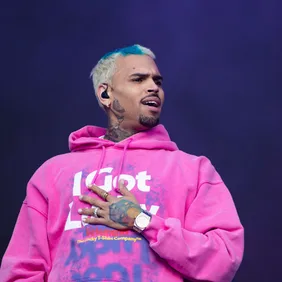When 50 Cent first started making noise, his sonic aesthetic was distinctly New York. Mixtapes like Power Of The Dollar and Guess Who’s Back put the young Curtis Jackson on the map as an emerging voice of the streets. Cut from similar fabric as peers like Raekwon and Ghostface, Fif’s depiction of the brutal realities of hood life were realized with a sense of observational glee. For the most part, he relied on a production core of Sha Money XL, Trackmasters, and Red Spya. They contributed admirably, proving 50 with a backdrop befitting of his visceral bars. Should you be wondering what formative 50 Cent might have sounded like, consider starting with “Life’s On The Line,” “U Not Like Me,” and “Corner Bodega.”
Around the time 50 Cent was slinging mixtapes, Dr. Dre was enjoying the success of his sophomore project, 2001. Consider that Power Of The Dollar dropped on July 4th, 2000; at that point, Dre was in the middle of the Up In Smoke Tour, having already produced the bulk of Eminem’s Marshall Mathers LP. Upon touching down, Dre began working as an executive producer on Restless, while crafting a few instrumentals for Snoop Dogg’s Tha Last Meal.
By this point, Dr. Dre appeared to be perfecting his preferred sonic aesthetic, which of course sits comfortably in “Dark Banger” territory. It’s likely that the addition to Scott Storch, and Mike Elizondo played a pivotal role in shaping his sound, which found an emerging emphasis on both piano and basslines. It’s fair to say that Dre retained that innate sense of eeriness he conjured during his work with Em, which one can describe as slightly carnivalesque. Though his subsequent work with Xzibit, Busta Rhymes, and Snoop was far from zany, the core elements remain a throughline. Minor key piano, often plonking (Xzibit’s “X,” Snoop’s “Lay Low,”). Ominous chord progressions realized through unconventional, horror-film soundscapes (Busta’s “Holla” and “Truck Volume)”. It’s safe to say that early millennium Dre promised a particular sound, miles removed from that the unrefined, and downright “greasy” tones of 50.

Frank Micelotta/Getty Images
Yet something about 50’s story spoke to Eminem, who received a copy of Guess Who’s Back from Paul Rosenberg. Upon realizing the rapper’s potential, Em brought him to Dre’s attention, and meetings proceeded to be set. Consider that Em and Dre had spent the last few years building an empire while Fif was still looking to earn his stripes. Signing seemed a no-brainer, despite the fact that their musical styles were basically disparate. Still, that didn’t stop Em and Dre from handling executive producer duties on Get Rich Or Die Tryin, bringing their own sense of musicality to the increasingly hyped debut.
I’ve already spoken at length about the fascinating chemistry between Eminem and 50; should you be interested, you can read about that here. In short, 50 found himself pulled into Eminem’s world, adapting to Shady’s production style and hyper-violent lyrical content. Of course, 50’s influenced rubbed off of Em as well, a shift especially evident in his string of “gangsta” cuts like “Welcome To D Block” and “Welcome To Detroit City.” Yet Dre was different. He never seemed to connect with Fif on a personal level like Em did. As is his way, he tapped into some of 50’s core elements and brought them to life. Given that Elizondo and Storch still made up his close-knit team, the overall sound remained consistent. But for 50, Dre and his camp crafted something truly wonderful.
It’s hard not to consider Dre’s four Get Rich Or Die Tryin contributions among the album’s best. “Heat” picks up where his work on Busta Rhymes’ Genesis left off, using a church organ as a foundational element; the other being actual gunshots, the most effective use of the sound since Bone Thugs’ “Thug Luv.” The track is the perfect playground for 50, who finds himself simultaneously emboldened by the violence, and encouraged by the triumphant chord progression. Said triumph continues into “If I Can’t,” which places the underrated multi-instrumentalist Elizondo in the well-earned spotlight; it’s difficult to imagine the 50 of “Corner Bodega” sounding so comfortable over polished, pristine, production, yet such is the effect of Dre and his camp.
50 Cent - "Heat" (produced by Dr. Dre)
“Back Down” is another example of Dre’s ear for the ominous. As per usual, his chosen progression favors the minor scale, which speaks to 50’s propensity for bringing sorrow upon his enemies. Could that be the root of their musical union? Perhaps. Yet it’s not all gloom. “In Da Club” finds Dre putting forth his best “Club Banger,” with assistance from Mike Elizondo & DJ Quik (!!!). Dare I say that the single is far from a conventional radio hit? The progression is somewhat dark, with a guitar line reminiscent of Busta’s “Break Ya Neck” (likely Elizondo’s handiwork), and imposing synth brass hits. In truth, one might be puzzled as to which direction is the wisest course. Such a quandary struck D12, who originally passed on the beat; it’s hard to imagine Swift McVay echoing “Go Shawty, it’s your birthday” with any genuine sincerity. Yet 50 heard something in the track’s infectious skeleton and proceeded to lay down one of the most successful lead singles in hip-hop history. By the way, do yourself a favor and check out 50 and Dre’s “In Da Hood”; a deep cut, but one of the most sparse and haunting selections of their repertoire.
The foundational elements set by Get Rich continued on Beg For Mercy, though Dre’s involvement had notably dwindled. This time around, he came through with a pair of Scott Storch co-productions: the piano-driven “Poppin Them Thangs” and the urban-gothic “G’d Up.” It became abundantly clear that Dre and 50 had developed distinct stylistic elements; the latter’s innate brutality proved a worthy compliment to the Doctor’s ear for menace. Sadly, however, the Dre and 50 partnership appeared to be waning, at least on a creative scale. The Massacre featured a pair of Dre instrumentals, and while both were enjoyable, neither quite reached the brilliance of their peak material.
Regardless of where things left off, people are still enamored with the idea that one day, 50 Cent and Dr. Dre will reunite on a record. Despite the fact that both have undergone complete stylistic transformations, with Dre in particular moving away from his 1999-2003 “Dark Banger” headspace. Yet those of us who experienced the rise of 50 Cent in real time will likely always remember their musical union, a truly unparalleled tandem. Instead of lamenting what will never be, reflect on what was, and how an era was all but crafted on the strength of five combined minds: Shady, Dre, 50, Storch, and Elizondo. Even if the Good Doctor and 50 never link up again, the music they've already given us will haunt the streets long after they're gone.
